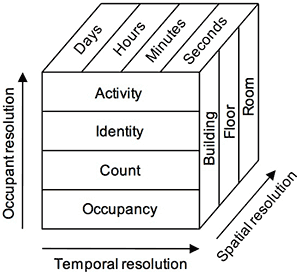 |
| Reviews and Templates for Expression We |
Using Existing IT to Determine Office Occupancy and Reduce Energy Use
Placed thoughtfully and in sufficient number, building occupancy sensors can provide data sufficient to reduce building energy use, and the potential savings are enormous. However, the time and expense involved in installing and maintaining dedicated occupancy sensors can hinder their widespread use. But what if those savings could be achieved more simply and cheaply, without having to install building sensors, and the data needed to manage a building's energy could be harvested from existing activities, such as keyboard use or the presence of a mobile phone?
Those were the questions that Bruce Nordman and Ben Rosenblum of Lawrence Berkeley National Laboratory's (Berkeley Lab) Environmental Energy Technologies Department (EETD) sought to answer with collaborators Ken Christensen and Ryan Melfi (University of South Florida) and Raul Viera (University of Puerto Rico).

Three fundamental dimensions of "presence" that existing IT infrastructure can determine beyond traditional occupancy's definition, which is a yes/no value.
The project focused on automated solutions that could be used to reduce or switch off electricity to specific equipment when it is not being used. Rather than relying on explicit occupancy sensing (such as passive infrared or ultrasonic motion sensors), the team used implicit occupancy sensing that drew data from occupants' interactions with the building's existing IT infrastructure. One such strategy is to monitor network addresses in Wi-Fi access points and routers and correlate those addresses with the occupancy of a floor, area, or room of a building. Delivery of services such as HVAC and lighting could then be adjusted accordingly.
The team evaluated the feasibility of this approach at the Engineering Building at the University of South Florida and Berkeley Lab's Building 90, and demonstrated an application of implicit sensing that showed its potential to sense the occupancy of a user workspace and automatically control its plugged-in devices. Three types of approaches were considered: those requiring only a data collection processing point, those that also required additional software, and those that required the data collection processing point and additional software and hardware.
The study showed that no-cost, implicit occupancy sensors were available within the existing buildings and demonstrated the feasibility of implicit occupancy testing. Advantages of using implicit sensors included: avoided cost for sensor installation and maintenance, availability of sensor readings over existing IT networks, and a degree of occupancy resolution (count, identity, and activity) not available from dedicated sensors.
Future work will focus on identifying the level of accuracy needed for optimal control of various equipment and demonstrate directly using the implicit sensing data in building controls.
|
|
|
|
Copyright 2011 Energy and Technical Services Ltd. All Rights Reserved. Energyts.com |